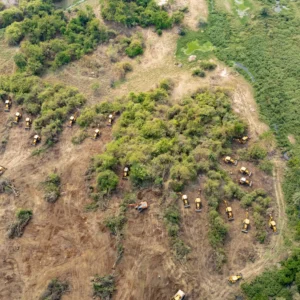Introduction: Hyderabad, a bustling metropolitan city known for its booming IT sector, rich cultural history, and modern infrastructure, is facing a major environmental crisis. The controversial cutting of a 400-acre forest in the Gachibowli-Kancha area has sparked public outrage, environmental concerns, and legal battles. Once a lush green haven, this forest area is now on the brink of being destroyed to make way for urbanization and commercial development.
In this blog, we’ll delve into the issue of the 400-acre forest cutting in the Gachibowli-Kancha region, explore the environmental and social implications, and discuss the ongoing court hearings that have arisen in response to this deforestation.
1. The Forest in Gachibowli-Kancha Area: An Ecological Gem
The Gachibowli-Kancha area, located in the heart of Hyderabad’s IT corridor, was home to a vast stretch of green forest. The forest, rich in flora and fauna, acted as a vital ecological barrier, preventing soil erosion, maintaining air quality, and regulating the local climate.
-
Biodiversity Significance: This region was home to numerous plant and animal species, many of which played an important role in the local ecosystem. The dense tree cover helped maintain groundwater levels, reduced air pollution, and acted as a habitat for a variety of birds, insects, and small mammals.
-
Climate Regulation: As with all urban forests, the Gachibowli-Kancha forest played a significant role in regulating the microclimate of the area. The trees absorbed CO2, provided shade, and helped cool the urban environment, which would otherwise be prone to the urban heat island effect.
2. Reasons for Forest Cutting
Several factors have led to the cutting of this 400-acre forest:
-
Urban Expansion and Real Estate Development: Hyderabad, particularly the Gachibowli area, has witnessed an unprecedented boom in real estate development in recent years. The demand for commercial and residential properties, IT parks, malls, and other infrastructure has resulted in large-scale deforestation in the region. This forest area, located near key business districts, was earmarked for construction.
-
Road and Infrastructure Projects: With Hyderabad’s rapid expansion, several infrastructure projects, including new roads and flyovers, were proposed for the area. These projects often require large tracts of land, including forests, which are cleared to accommodate urban sprawl.
-
Industrial Growth: Hyderabad’s transformation into a global IT hub has led to a surge in industrial development. Many companies and businesses have set up offices in Gachibowli, and there is immense pressure to create space for new commercial complexes and tech parks. This further contributed to the need for clearing large parts of the nearby forests.
3. Environmental and Social Impact
The 400-acre forest cutting in the Gachibowli-Kancha area is not just an environmental tragedy, but it also has severe social implications:
-
Loss of Biodiversity: The clearing of this forest means the destruction of wildlife habitats. Species that once thrived in the area are now at risk, with some species possibly facing local extinction due to habitat loss.
-
Increased Pollution: The forest’s role as a natural air filter is irreplaceable. The removal of trees

-
means a reduction in the absorption of carbon dioxide and other pollutants, resulting in an increase in air pollution. The loss of greenery also contributes to higher temperatures in the urban area, leading to more intense heat waves.
-
Displacement of Local Communities: The forest was not only home to wildlife but also to many local tribal and forest-dwelling communities. With the deforestation, these communities face displacement, loss of livelihoods, and cultural erosion. The destruction of their land and natural resources has a direct impact on their well-being and survival.
-
Water Scarcity: The forest’s role in water retention and groundwater recharge is critical. Without the trees and the natural filtration they provide, the region may experience more frequent and severe water shortages, affecting agriculture, urban consumption, and local ecosystems.
4. Court Hearings and Legal Action
In response to public outcry and the environmental damage caused by the cutting of the Gachibowli-Kancha forest, several court cases have been filed by environmental activists, concerned citizens, and local NGOs.
Key Court Developments:
-
Public Interest Litigations (PILs): Environmental organizations have filed PILs in the Telangana High Court, questioning the legality of the forest clearance and demanding a halt to further deforestation. These petitions argue that the forest clearance violated several environmental protection laws, including the Forest Conservation Act of 1980, which mandates a thorough environmental impact assessment (EIA) before any forest land can be diverted for non-forest use.
-
Environmental Impact Assessments (EIA): One of the main concerns raised in the court hearings is the lack of a comprehensive EIA. Environmental groups argue that the state government did not follow the required process of assessing the ecological impact of clearing such a vast area of forest. Without a proper EIA, there’s no way of gauging the long-term consequences of this deforestation.
-
Court Orders and Interim Stays: The Telangana High Court has intervened in this case by issuing a temporary stay on the further cutting of trees in certain sections of the forest area. These orders have provided some relief to environmental activists, but the fate of the
 entire 400-acre area remains uncertain.
entire 400-acre area remains uncertain. -
Future Hearings: The courts are set to hear the case in the coming months, with government authorities expected to present their defense regarding the necessity of the deforestation for urban development. The next hearings will likely determine whether any action is taken against the officials responsible for the forest clearance or whether the construction projects will proceed.
5. Potential Solutions and Sustainable Development
While the situation remains tense, there is hope that a balanced solution can be found. Several steps can be taken to address the issue while ensuring that development continues in a sustainable manner:
-
Reforestation Initiatives: The state government can invest in large-scale reforestation programs to replace the lost forest cover. This could help mitigate some of the environmental damage caused by deforestation and restore habitats for wildlife.
-
Green Infrastructure: Instead of clearing forests for urban projects, planners could explore the concept of “green infrastructure,” where nature is integrated into urban development. Green spaces, rooftop gardens, and eco-friendly buildings can help maintain biodiversity and improve the quality of life in cities.
-
Public-Private Partnerships: Government bodies, NGOs, and private corporations can collaborate to promote sustainable development practices that prioritize environmental conservation alongside infrastructure growth.
-
Awareness and Advocacy: Public awareness campaigns can educate citizens about the importance of protecting urban forests. More involvement from local communities, environmental groups, and the public can help pressure authorities to adopt greener policies.
6. Conclusion: A Critical Turning Point
The 400-acre forest cutting in the Gachibowli-Kancha area is a significant environmental issue for Hyderabad. While urban growth and development are essential for the city’s economic progress, it’s equally important to protect natural resources like forests that sustain life.
The ongoing court hearings will determine the future of the Gachibowli-Kancha forest, and the outcome could have far-reaching implications for how the state handles environmental conservation amidst urban expansion.
It’s crucial that the citizens of Hyderabad, along with government agencies and environmental advocates, work together to strike a balance between development and nature preservation. The city’s future depends on it.




